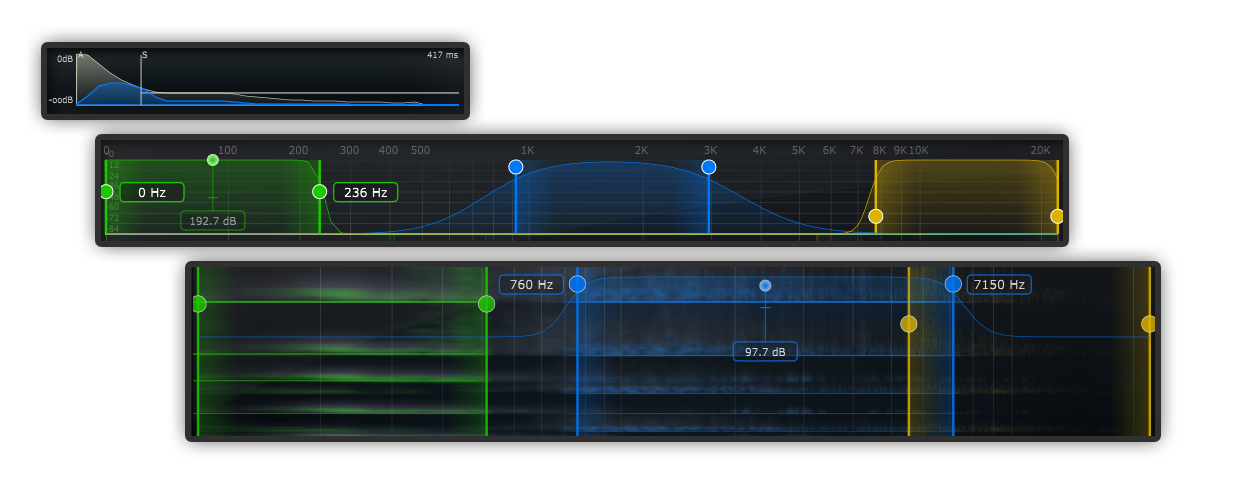Download free Trial ... Buy now ...
Renew your experience in transient processing
The polyphonic spectral separation, used for the first time in a transient shaper, allows the envelope of each polyphonic 'note' to be processed according to its own time base, even in polyphonic audio material, without affecting other sounding notes.

The Transient Artist
With atomictransient, your audio sources and samples match the mix perfectly:
- Change dynamics of recordings, samples and existing loops
- Use atomictransient for percussion patterns, but also for instruments or loops/mix patterns
- Adjust the complete temporal envelope of existing audio material
- Separate, accentuate or remove drum hits from loops or patterns
- Simulate piano pedals, change the guitar attack, or reshape the envelope of a synthesizer sample. Each note is adjusted in its own time domain
Integration
Use atomictransient in of your DAW for any type of track as needed.
Regardless of whether you use it for drum patterns, loops from your DAW library, polyphonic instrument recordings or midi instruments. You can also easily edit existing mixes.
atomictransient works with any audio material that contains transients/beats!
"You can work with polyphonic material in a way
that I haven't realized will be possible before" (Sonicstate, übersetzt)
Multichannel / Mixer
atomictransient provides up to three parallel processing channels. Each channel can detect and process transients in its own frequency range and uses different effects on the audio signal.
The detection of transients per channel can be limited by a spectral filter to a specific frequency band, so that a transient is triggered only for chosen audio material.
The effect outputs can be mixed to defined frequency ranges - parameters control the amount of effect and original signal.

Polyphony
In addition to working across the entire frequency spectrum or processing drum patterns, atomictransient 'understands' polyphonic audio signals such as pianos, guitars or mixes with various instruments.
A special analysis separates the audio introduced by transients according to their spectral components. Thus, the polyphonic mode uses the characteristics of a signal to apply the selected effect to relevant spectral ranges after a transient or new sound has occurred.
Polyphonic audio material such as piano, guitar or mix-downs can therefore be processed 'polyphonic', so that already sounding tones are not affected by new tones and effect processing is performed separately for each tone or note. This is comparable to the selective modification of overlapping "notes" of an instrument or track.
atomictransient allows, for example, only bass instrument, base drum, snare or hi-hat to be nearly removed, separated, sustain added or attack changed. This way, piano pedals can be simulated, guitar strokes changed or the envelope of a synthesizer sample reshaped. Each note is adjusted in its own temporal progression.

Effects
As soon as a transient is detected, atomictransient 'triggers' the processing of this transient sound and all spectral components associated with it. A triggered transient results in the processing of the audio signal by an effect that starts at the moment of the triggering event.
The built-in effects allow a variety of settings to control the effect used by the transient processing for each channel. There are currently two effects available - 'Envelope Response' and 'LFO Filter'.
The 'Envelope Response' controls the amplitude over time, changing the signal 'dynamically' (relative to the current amplitude and time) or 'statically' (independent of the current amplitude). This enables a precise adjustment of drum lines by changing attack and sustain, and also gives instruments a new character by changing the entire envelope..
The Filter effect dynamically modifies frequency ranges via timed LFOs. By adjusting the resonance, a typical concise character can be given to the sound.

Interactive live displays
atomictransient features several live displays:
- The spectral display is mainly used to check and control the triggers
- The time-based 'waterfall diagram' shows a historical representation of all transients, channel and signal information and is used to control the effect response
- The Live Display of the Envelope effect shows the amplitude of the current signal with input and output level modification. In order to adjust the envelope optimally, atomictransient extracts a visual representation of the real amplitude response of the current signal
And even more...
More than 160 presets offer enough possibilities to get started right away. The presets are specially grouped for different types of audio material such as drum patterns, instrument loops and mixes and also contain a number of sets of effect, timing and filter presets.
Two different "listen" functions support the optimal setting of parameters - once activated, only the output of the transient detection is audible to check the filter settings of the transient trigger or the output of the current effect.
atomictransient supports even common parameters like dry/wet, gain and dynamic automatic gain. The A/B program comparison and preset copy & paste simplifies preset creation. Presets can be exported or imported as XML text either completely or per setting category. Undo and Redo make it easy to navigate through changes you made.
Using the integrated MIDI-learn function, parameters can be assigned to MIDI controllers via your host-software.
For optimal usability atomictransient also supports a scalable user interface and two different designs.
.
Standalone application (Windows)
For Windows-Systems a standalone application is included to use atomictransient directly as a dynamic-effect through your audio-hardware.

Listen to what you can do with atomictransient
All examples were created with atomictransient as a single track within a DAW (other plug-ins used are listed in the description of the respective example). The examples contain the original (dry) followed by several edited parts (wet) using different presets / settings.
Watch preview videos of the community





